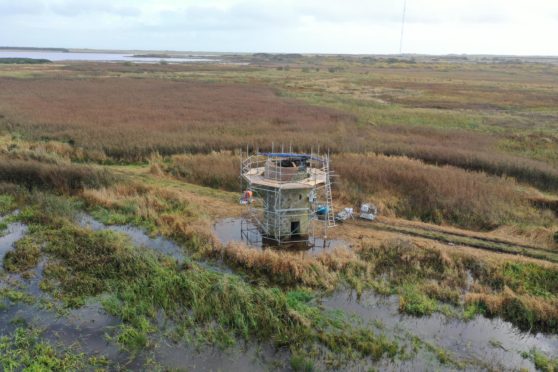The remains of a 230-year-old windpump at the heart of a north-east nature reserve have been preserved for future generations, thanks to a major refurbishment project.
As well as being the nesting grounds and a key stopping-off point for all manner of birds, the RSPB reserve at Loch of Strathbeg between Peterhead and Fraserburgh is also home to an 18th Century scheduled monument.
The loch’s windpump, which was once used to drain the area to increase the amount of available farmland, has long since lost its sails.
Its stone tower, however, still stands as a key reserve landmark and a reminder of the area’s agricultural heritage.
Over the years, the structure had gradually decaying, prompting concerns from conservationists and calls for action.
Now, after grant support from Historic Environment Scotland and others, the pump’s tower has been completely repaired and should continue to stand proudly at the loch for years to come.
Jill Harden, the RSPB’s archaeologist for Scotland and Northern Ireland, said the repair work reflects the organisation’s “commitment to Scotland’s environment and local communities”.
Efforts to boost agriculture key to Loch’s survival
“The tower with its mechanism and sails was built in the 1780s to pump water out of a larger Loch of Strathbeg,” she said.
“Agricultural improvers wanted to increase the amount of farmland in the area.
“Drains were dug and sluices created to ensure the system worked and though it was only partially successful the Loch of Strathbeg survives today.
“Go westwards along the coast and some lochs have almost completely disappeared – such as the once extensive Loch Spynie, north of Elgin.
“The Strathbeg windpump continued pumping away until the early 20th century, although for the last 30 or 40 years it was powered by a generator rather than wind.”
The Loch of Strathbeg is one of the largest dune lochs in the UK and acts as a vital wintering spot for up to a fifth of the world’s pink-footed geese.
Other birds that can be seen at the reserve include whooper swans, lapwings, redshanks and terns.
The site is also home to a herd of Konik ponies, which graze the land and help to make room for smaller, delicate flowering plants.
A delicate conservation project
Ms Harden thanked Masonry and Lime Ltd of Elgin and the chartered surveyors Glyn Young Associates of Inverness for their work on the conservation project, which proved trickier to complete than was initially thought.
“For both, the challenge of securing the cast iron features at the top of the tower was extreme,” she said.
“We hadn’t realised just how precarious the over half-a -tonne of machinery was.
“Nobody had been able to get to the top of the tower before the works began – we were relying on drone photography.
“Now we knew the remaining timbers were completely rotten and hardly had any load-bearing strength left.
“But a solution was agreed upon and the works team used block and tackle, raised the upper cogs and shafts and then took out the paper-thin wood.
“They then raised the heavy oak beams and manoeuvred them into place.”
The repair work had been planned since 2014 and required a great deal of preparation, funding submissions and careful planning to ensure the important history of the structure was preserved as much as possible.
Ms Harden added: “Visitors will be able to enjoy viewing the newly-repaired tower as they look out at the loch from the centre.
“With birds and visible history all in one view it is fantastic.”
